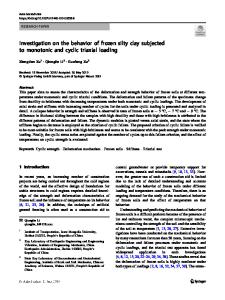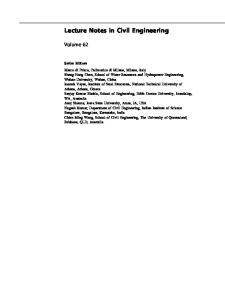Deformation of amorphous silicon nanostructures subjected to monotonic and cyclic loading
- PDF / 634,564 Bytes
- 8 Pages / 612 x 792 pts (letter) Page_size
- 9 Downloads / 338 Views
R.C. Picua) Department of Mechanical, Aerospace and Nuclear Engineering, Rensselaer Polytechnic Institute, Troy, New York 12180-3590 (Received 2 March 2007; accepted 29 June 2007)
An atomic force microscope (AFM) was used to characterize the deformation behavior of amorphous Si (a-Si) nanostructures subjected to monotonic and cyclic loading. The sample geometry was specially designed (in the form of elbow) using finite element modeling for the purpose of these tests, and the samples were grown by glancing angle deposition. When deformed monotonically at room temperature, the a-Si specimens exhibited a nonlinear force–displacement response at forces larger than a critical force, a phenomenon not observed in bulk silicon. A fatigue testing methodology based on the use of the AFM was established. The fatigue life of the a-Si specimens was observed to increase by five orders of magnitude with a 50% reduction in the applied force amplitude. It was verified that this delayed failure is caused by progressive damage accumulation during cyclic loading. These results are compared with literature data obtained from micron-size specimens.
I. INTRODUCTION
The increasing use of small micromechanical devices, advanced sensors, biomedical instruments, etc. has not only led to concerns about their long-term reliability issues but has also generated a scientific interest in understanding the deformation mechanisms of these reducedsize structures. The long-term durability is limited by the operation of microscopic mechanisms that allow flaws to develop or existing flaws to grow. Although bulk silicon is not known to exhibit fatigue susceptibility, micronscale film structures made from silicon are known to degrade during cyclic loading in the ambient.1 Many studies dedicated to Si are specifically concentrated on evaluating the elastic properties of the crystalline (c-Si) and amorphous (a-Si) material by performing monotonic bending tests of horizontal or slanted nanobeams.2–5 The elastic properties of these specimens are found to be similar to those of the bulk material. There have been a few but significant studies of the fatigue behavior of microelectromechanical system (MEMS) polysilicon thin-film specimens. These are vibrating structures such as oscillators and comb drives,6–8 notched cantilever
a)
Address all correspondence to this author. e -mail: [email protected] DOI: 10.1557/JMR.2008.0061 328
http://journals.cambridge.org
J. Mater. Res., Vol. 23, No. 2, Feb 2008 Downloaded: 19 Mar 2015
beams,9 and tensile microspecimens.10 These studies demonstrated that fatigue behavior of micron-scale specimen is different from that of larger silicon specimens. Two classes of mechanisms have been proposed to explain this observation. The first is based on subcritical cracking in the silicon oxide surface layer (reaction-layer fatigue), while the second is associated with subcritical cracking in the silicon itself. However the issue remains contentious.11 Nanoindenters and atomic force microscopes (AFM) have enabled the study of mechani
Data Loading...










